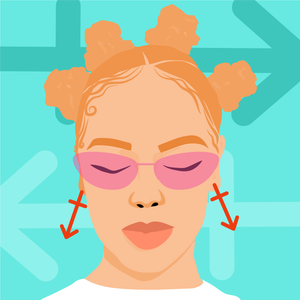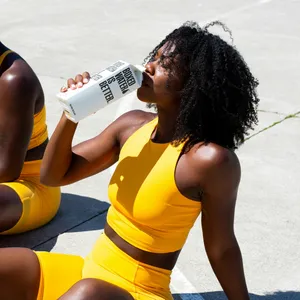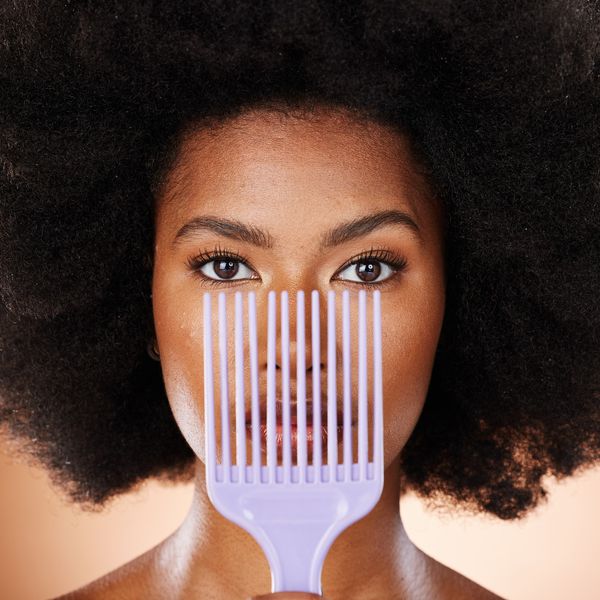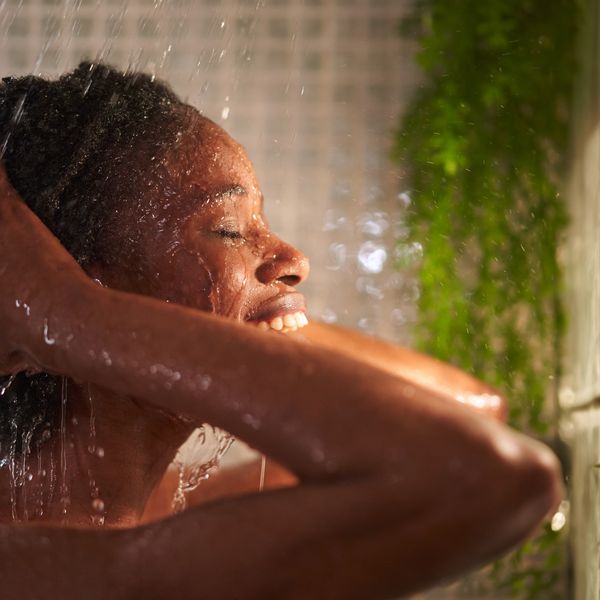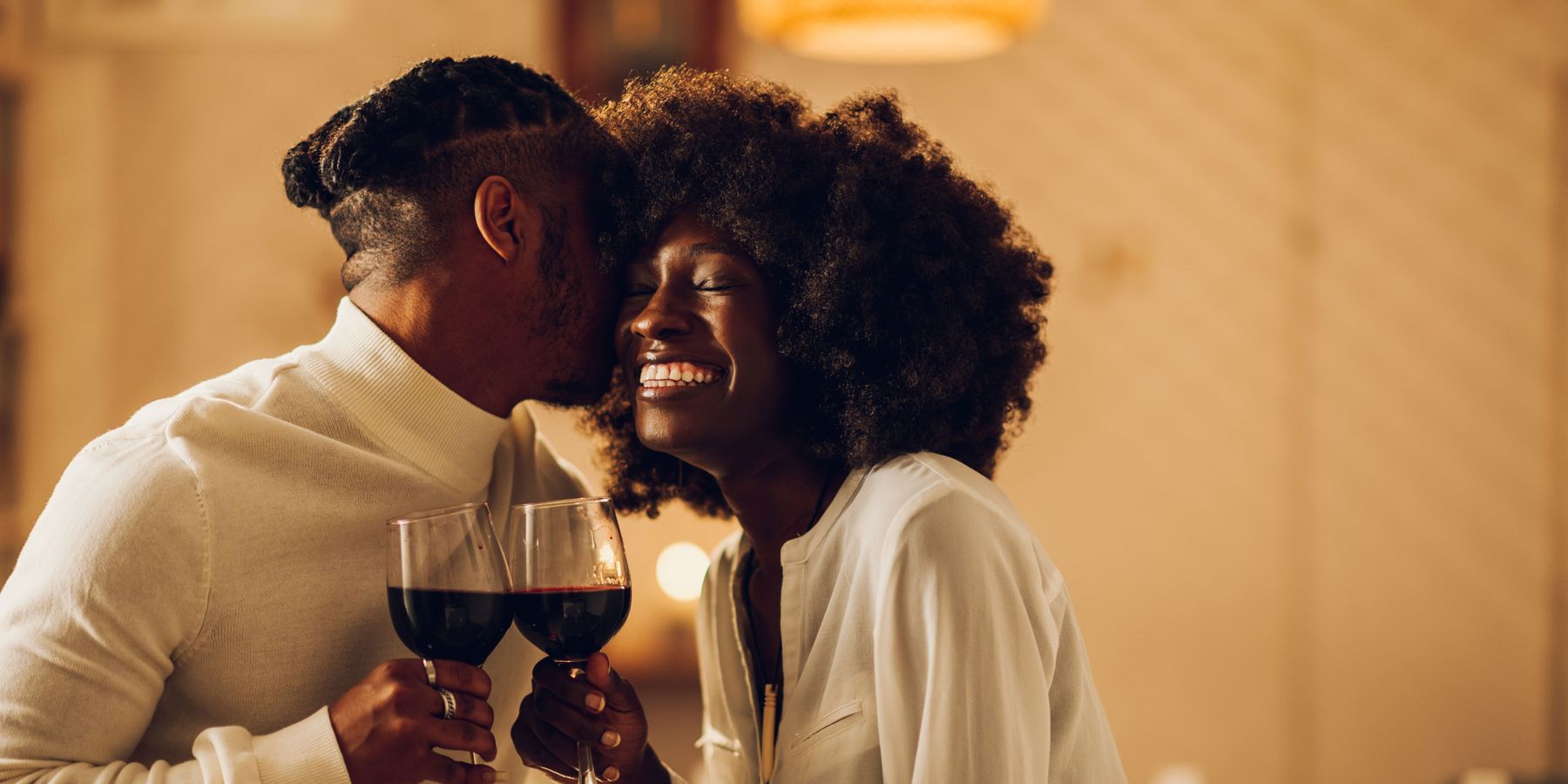
It's kinda crazy what inspired me to pitch and then pen this article. I was watching Usher's visual for "Bad Habits" while trying to figure out why a particular small area of my hair was thinner than it needed to be. I came to the conclusion that it was because I was manipulating it too much by always taking that particular cornrow down and braiding it up again. And that got me to thinking about so many of the bad natural hair habits that a lot of us have; ones that prevent us from getting the long-term hair results that we want.
If you're sick of your own tresses not flourishing as much as you would like, take a moment to see if any of these habits are ones that you definitely need to break.
1. Keeping Your Protective Style in Longer Than You Should
I don't know one naturalista who hasn't heard that one of the best ways to achieve length retention is by putting their hair up in a protective style. As I said a second ago, my hair is currently in cornrows (a personal favorite style of choice). I dig them because, not only do they keep me from having my hands in my tresses all of the time, but protective styles are also a great way to protect my ends as well (damaged ends are the main reason why most of us don't get the inches that we want). Still, too much of a good thing can easily work against you.
In this case, if you've got your hair in some braids or twists (via your natural hair), they really need to remain in there for no longer than a couple of weeks. Braids and twists with extensions, you're pushing it if you keep them in for longer than two months. The reason why is because your hair and scalp need to be thoroughly washed and to take a break from the stress that protective styles can cause if you've got them in for too long. One day, I'm gonna share how protective styles can actually be the reason why your hair isn't growing. For now, though, just don't keep them in for a billion years. It's the kind of bad habit that doesn't get discussed, nearly enough.
2. Using Too Many Damn Products in Your Hair
The beauty industry is a billion-dollar one and we as Black women play a HUGE role in why that is the case. That said, I know there are tons of products out here that make all sorts of promises. But you've gotta remember that companies are looking to make revenue. This means that if they've gotta lie to you and say they have a serum that will fix your split ends (nothing fixes split ends; you have to trim them), that is exactly what they will do.
Anyway, while I'm all about finding products that work best for your hair if you use a lot of them at the same time or you keep switching up, all that's gonna do is either weigh your hair down and clog up your hair follicles (not good) or end up damaging your hair because not all products are created equal and your hair shouldn't be treated as some guinea pig or science project. It typically takes about two months to figure out if something is really your jam on the product testing tip. Try a couple of things out at a time and stick to what works for you, even if it's only a few products. Less is more is always best when it comes to hair care.
3. Not Knowing Your Hair Type and Texture
Let me tell it, I think women struggle with knowing what their hair type is about as much as they struggle with figuring out their correct bra size. When it comes to hair type, the numbers run from 1-4. 1 is straight. 2 is wavy. 3 is curly and 4 is coily. Then there are letters that go with each number, ranging from A-C. A is fine. B is medium. C is coarse. As far as your "numbers" go, YouTubers like Angela C. Styles, IAMTRAEH, and LavishlyBritt all have videos that break hair types down pretty well. As far as your hair's texture, a cool figuring-it-out hack is to take a piece of thread and lay it on a flat surface. Then place a strand of your own hair beside it. If your hair appears thinner than the thread, your hair is fine. If it's the same size, your hair is medium. If it's bigger, it's coarser.
Having this information is essential because it can help you to better understand how to properly care for your hair, what products work best, and ultimately how to keep it thriving. For some tips on all of these things, go to YouTube and put your hair type and texture, along with "natural hair" in the search field and you will see literal days' worth of videos pop up so that you can get to know your hair, even better.
4. Using the “Wrong” Styling Tools for Your Natural Hair
A lot of stylists will tell you that using your hands to detangle and style your hair as much as possible is oftentimes a good look because you can be gentler with your locks than you can with styling tools. But when it comes to the things that you absolutely do need, make sure you've got—a wide-tooth comb; some plastic hair clips (the metal ones tend to snag and tear); a Denman brush; a hair steamer (to lock in moisture); a microfiber towel (it's easier on your hair during wash days) and a blow dryer for your hair type (Red by Kiss Blow Dryer gets a lot of praise if you're a 4-type).
While this is a basic list, the main thing to keep in mind is a lot of metal, a ton of heat or anything that will cause your hair to snag and tear are absolutely no-nos. You really don't need a ton of styling tools; just things that will make getting the results that you want as easy as possible without creating any drama in the process on those pretty tresses of yours.
5. Mishandling Wet Hair During Wash Days
Your hair is definitely the most fragile when it's wet. That's why it's best to detangle your tresses with your fingers as much as possible, to deep condition after shampooing so that your hair is more manageable, and to apply a product that has some "slip" to it when you're using a detangling comb or you're doing something like braiding or twisting your hair for a braid out or twist out. Otherwise, you could end up ripping some of your hair out or weakening the cuticles during the styling process. As far as slip goes, if you'd like a little help figuring out which product would work best, Naturally Curly gave some slip awards to a few. You can check them out here.
6. Trimming Your Hair More than Dusting
One of the reasons why I stopped going to see a professional stylist was because far too many of them don't seem to know the difference between dusting and trimming. Hmph. I've always wondered if a lot of stylists have a secret vendetta against their clients gaining inches because I don't always need a bob— thank you, very much. Whew. Plus, as I've learned more about what does and doesn't work for my hair, I've become a big fan of dusting. Dusting is about getting rid of the raggedy or split ends that you may have without getting rid of 2-4 inches of hair in the process.
If you're nervous about attempting this, the main thing to keep in mind is you need a pair of sharp shears and a good amount of patience. Click here, here and here to watch some videos on how to dust.
Oh, and for any stylists that may have side-eyed me for what I said, I know there are some great ones out there and that some folks wouldn't be able to walk outta the house without one. At the same time, I believe a good one also isn't scissor happy. I'm thinking that we all can agree on that.
7. Having a Complex Relationship with Heat
Contrary to popular belief, I personally don't think that heat is the enemy; I think using heat the wrong way is, though. Back when I got on board with the whole "heat is the devil" movement, I actually experienced a lot more breakage than I do now that I blow my hair out every wash day and then leave it in a protective style (other than the weekends) until the next wash day. I believe it's because this method stretches out my hair so that there is less tangling and it also helps me to nurture my ends easier.
Anyway, that's not to say that huge mistakes aren't oftentimes made in this lane, mostly because people use the wrong kind of heating tools, apply them when they're too hot and/or use them too often. If you're in search of a good blow dryer for your natural hair, Byrdie recently published an article that features 12 (click here). After getting one, always make sure that your blow dryer is on low-to-medium heat and that you ONLY use it once your hair is about 60 percent dry on its own (the drier it is, the less you will be able to singe it). And try not to apply heat more than 2-5 times a month. More than that can definitely damage your hair and even alter your natural curl pattern.
8. Being High-Maintenance with Your Edges
Lawd, the internet. I'm pretty sure some of y'all saw the post of the young lady who mistook Gorilla Snot (which is already quite a beast when it comes to laying hair down) for Gorilla Glue. Well, at the time that I'm writing this, her hair literally hasn't moved in a month. Like…at all which resulted in her going to the ER (check her take on it here and a radio interview with her here). When I watched the video, the first thing that came to my mind is how obsessed a lot of us are with keeping our edges as laid as possible.
Listen, there's no time to get into how I believe that European culture has played a certain role in us having a preoccupation with baby hairs as grown women (goodness). For now, I'll just say that probably the most fragile parts of your hair are your edges and nape. So, constantly weakening your edges' hair follicles by always brushing them down, drying that part of your hair out with gels, and always applying pressure with braids, lace fronts and wigs are all surefire ways for your edges to either thin out or bald altogether.
If you must gel those babies down, make sure to use a non-alcohol gel (Allure published a feature on some of the best edge controls around; check it out here) and definitely give that area a break a few days a week. Sleek edges are cool, but you know what's even better? Having edges, period.
9. Jacking Up Your Wash ‘N Go
When it comes to low-manipulation hairstyles, wash 'n gos always top the list because you don't have to do a lot of styling and touching of your tresses in order to end up with a really cute look. That doesn't mean that too much of a good thing can't go awry though. The wrong products, tugging too much on your hair while it's wet and not knowing how to cultivate a bedtime routine that will result in you messing with your hair as little as possible the following morning all have to be factored in to make this a good idea for your natural hair texture.
If you want to make sure that this heat-free look goes off without a hitch—wash your hair with a sulfate-free shampoo; deep condition your locks; rinse your hair in cool water (it will keep your cuticles smooth); apply a curl cream (if you've got tighter coils) or add a carrier oil as a base to it (if you've got a looser curl texture) to set your curls, and keep your hands COMPLETELY out of your hair until your tresses dry (otherwise, you could end up with a significant amount of frizz). Wrap your hair up with a silk scarf or satin bonnet at night and refresh in the morning with a light leave-in conditioner. And try and let your wash 'n go be for about a week. Remember, low manipulation is always the key to stronger hair. You can get some other wash 'n go hacks by checking out this video, this video, this video, this video and this video.
10. Being Too Reliant on Your Wigs
Wigs can be dope; especially the kind that exists these days because I promise you that some, I can't even tell that they are wigs at all (like this line right here). Not only can wigs help you to avoid over-manipulating your hair, but they can also protect your tresses from outer elements, encourage your styling creativity without a lot of drama, and save you a ton of time when it comes to your morning routine.
Just remember that a wig is not your natural hair (no matter how much it may look or feel like it). If you've got a human hair well-secured, it can last for up to six weeks (if you take care of your natural hair that's underneath); just don't go beyond that. As far as sleeping in wigs, it really is best to remove them. If you opt not to, don't go more than a few days without doing so. Your hair and scalp need to breathe. Your edges need a bit of a break from the stress and tension of the wig too.
11. Not Taking a Multivitamin
There is plenty of data that says most of us don't get nearly enough nutrients from food alone. This is where multivitamins come in. They are a great way to supplement what you may be lacking which can result in everything from a strengthened immune system and healthier heart to more energy and beautiful hair, skin and nails. There are loads of vitamins on the market, so it's kind of hard to recommend a specific brand. You might want to look for one that specifically says "for hair, skin and nails" on it. Whatever you do, just make sure there are vitamins A, B12, C and E, iron, biotin and zinc in the product that you decide to go with. One that contains collagen is definitely a bonus. Oh, and if you opt for a liquid form, not only does it hit your system faster, it tends to be more potent too.
12. Stressing Out
If there is one thing that I have learned to become more and more intentional about, it's not letting any person, place, thing or idea stress me out. It's just not worth it. PERIOD. This includes when it comes to protecting my hair. Did you know that constant stress can throw off your cortisol levels and literally push your hair into a resting phase that can hinder it from growing? No joke. So, if you've got some job or man who is driving you up the wall and you're noticing some shedding or even thinning as far as your hair is concerned, don't tell yourself that it's all in your head. There is a very real chance that you are going bald due to anxiety. Release what's got you in that state. Your hair will thank you for it.
BONUS: STOP COMPARING
Iyanla Vanzant once said, "Comparing yourself to others is an act of violence against your authentic self." Out of all of the mistakes that we could possibly make when it comes to our hair, I promise you that the biggest one is comparing your tresses to someone else's. When God made you, he took out just as much time as he did on his other daughters. Don't insult him by acting like you somehow got a shorter end of the deal because, I can say from very personal experience, that once you get a real understanding of how your own hair works, you'll come to adore its individuality. You really will.
You'll wake up knowing that your hair is a gift, that there isn't one thing wrong with it, and that you are truly blessed. That your Creator made not one mistake. Amen? Amen.
Featured image by Giphy
- How To Determine Your Hair Type - xoNecole: Women's Interest, Love, Wellness, Beauty ›
- Protective Styles Not Working - xoNecole: Women's Interest, Love, Wellness, Beauty ›
- Taking Care Of Your Natural Hair While Traveling - xoNecole: Women's Interest, Love, Wellness, Beauty ›
- Tracee Ellis Ross' 'Hair Tales' Is About More Than Hair - xoNecole: Women's Interest, Love, Wellness, Beauty ›
- Pattern Beauty Blow Dryer Review Tracee Ellis Ross - xoNecole: Women's Interest, Love, Wellness, Beauty ›
This Is How To Keep 'Holiday Season Stress' From Infecting Your Relationship
Hmph. Maybe it’s just me, but it seems like there is something really weird happening in the fall season air (because winter doesn’t officially begin until December 21) that cuddle season is in full swing while break-up season is as well. In fact, did you know that break-ups are so popular during the holiday season that December 11 is deemed Break-Up Day?
The reasons why relationships shift around this time vary; however, I did both roll my eyes and chuckle when I read that a very popular one is because it’s an easy way to get out of getting one’s significant other a Christmas present. SMDH.
Anyway, I personally think that the less shallow folks out here may contemplate calling things “quits” or they at least distance themselves a bit from their partner (and what I’m referring to is serious relationships) due to all of the stress and strain that oftentimes comes with the holidays whether it be financial, familial, due to their tight schedules or something else.
Listen, I would hate for you and your man to miss the fun and happiness of experiencing this time of year, all because you are so overwhelmed or irritated that you can’t really enjoy it. That’s why I have a few practical tips for how to avoid allowing the typical holiday season stress from INFECTING your relationship.
Manage Your Expectations
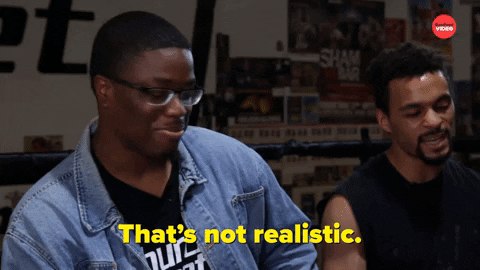 Giphy
GiphyUnmanaged expectations. If there is a main reason why the holiday season tends to be so stress-filled for so many people, I’d bet good money that this is the cause. And when you’re in a long-term relationship, expectations can manifest themselves in all sorts of cryptic and/or unexpected ways. You might have relatives who assume that you are going to be with them for Thanksgiving or Christmas when you have other plans in mind. You might be thinking that you are going to spend one amount for presents while your man is thinking something totally different. When it comes to scheduling, your signals may be crossed.
And you know what? To all of these scenarios, this is where clear and consistent communication come in. Don’t assume anything. Don’t dictate anything either. From now until New Year’s, mutually decide to check in once a week, just to make sure that you are both on the same page as it relates to the holidays and what you both are thinking will come along with it. The less blindsided you both feel, the less stressed out you will be. Trust me on this.
Set (and Keep) a Budget
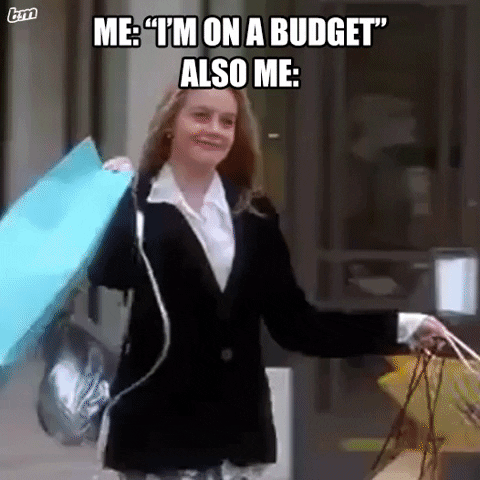 Giphy
GiphyOkay, so I read that last year, 36 percent of Americans incurred some type of holiday-related debt. Hmph. Last year, there was still some sense of normalcy in this country, chile, so I can only imagine what finances are gonna look like over the next several weeks. That said, since I don’t know a lot of people who don’t find being broke stressful, make sure that you and your bae set a budget and then stick to it this year — no ifs, ands or buts.
Because really, y’all — it doesn’t make sense to deplete savings and/or max out credit cards for a few days of giggles only to be damn near losing your mind because you don’t know how to make ends meet come Dr. Martin Luther King, Jr. Day.
And by the way, this tip doesn’t just speak to things like food and gifts; I also mean travel. If it doesn’t make a ton of sense (or cents) to be all over the place this year — DON’T BE.
Keep Matthew 5:37 at the Forefront
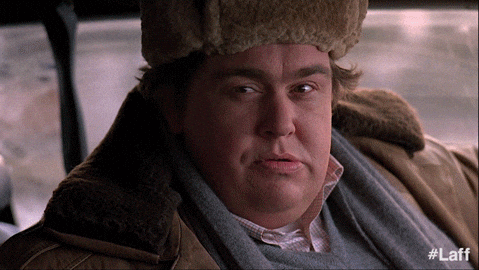 Giphy
GiphyIf off the top of your head, you don’t know what Matthew 5:37 says, no worries, here ya go: “But let your ‘Yes’ be ‘Yes,’ and your ‘No,’ ‘No.’ For whatever is more than these is from the evil one.” That verse right there? Oh, it’s a boundaries lifesaver! I say that because do you see “maybe” or “I’ll think about it” in there? Nope. LOL. It says that you should tell people “yes” or “no” and leave it at that — and that complements Anne Lamott’s quote, “’No’ is a complete sentence” impeccably well. Yeah, you’ve got to remember that anything beyond a yes or no to a request is privileged information; you don’t owe anyone details or an explanation.
Besides, if you are really honest with yourself, when someone asks you something and you give a “Umm, let me think about it” kind of reply, more times than not, you already know what your answer is going to be — so why not let you both off of the hook? Give your response. Commit to that. And let everyone (including yourself) get on with their lives and schedules.
I promise you that when it comes to those holiday parties, you are pissing more folks off by not RSVP’ing or doing so and not showing up than just saying, “Thank you but not this year” off the rip.
Remember That Your Personal Space Is Privilege Not a Right
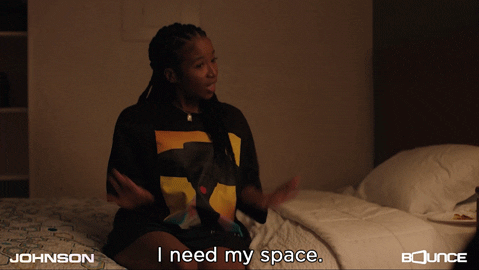 Giphy
GiphyA friend of mine recently bought a new house and invited me over to come see it. He’s a single man with no children, so as I was taking in all of the space that he had, especially as I walked through his finished basement, I joked about relatives coming to live with him. “Hell no” and “absolutely not” were pretty much his immediate responses as he went on to say that some folks even had the nerve to be offended when he told them that he had no intentions on taking DNA in.
Ain’t it wild how people think that your stuff is their right? And yes, that brings me to my next point. Your home is your sanctuary space. If you want to host folks this year — cool. If not, ALSO COOL. Please don’t let folks (family included) guilt you into how they want you to act or even into what they would do if the shoe was on the other foot. You are not them — and as one of my favorite quotes states, “If two people were exactly alike, one of them would be unnecessary.” (A man by the name Larry Dixon said that.)
Hell, my friends? They know that I am good for sending them random things that they need or even want all throughout the year. Coming over to hang out at my pace, though. Uh-uh. Chalk it up to being a card-carrying member of the ambivert club yet I like keeping my living space personal — and I sleep like a baby, each and every night, for feeling that way.
Always remember that your space, your time, your resources, your energy and shoot, yourself period (including your relationship), are all things that are your own. You get to choose how, when and why you want to share them. The holiday season is certainly no exception.
Cultivate Some “You Two Only” Traditions
 Giphy
GiphyIt’s not uncommon for some couples to hit me up after the holiday season to “detox.” Sometimes it’s due to the financial drama (and sometimes trauma) that they experienced. Sometimes it’s because they allowed their relatives (especially in-laws) to get more into their personal business than they should’ve. More than anything, though, it tends to be because they didn’t get enough quality time together and so ended up feeling “disconnected.”
Please don’t let that happen. Listen, I’m not even a holidays kind of woman and yet, I will absolutely sit myself down with some hot chocolate and chocolate chip cookies to enjoy a Hallmark holiday film or two. Aside from the fact that most of them are lighthearted and sweet, I also like that they usually focus on couples loving on each other amidst all of the holiday beauty and ambiance — which is something that all couples should set aside some time to do.
Maybe it’s a vacation. Maybe it’s a staycation. Or maybe it’s my personal favorite, A SEXCATION. Whether it’s for a few days, the weekend or even overnight — don’t you let the holidays go by without setting aside time for you and your man to celebrate one another. Don’t you dare (check out “Are You Ready To Have Some Very Merry 'Christmas Sex'?”).
GET. SOME. REST.
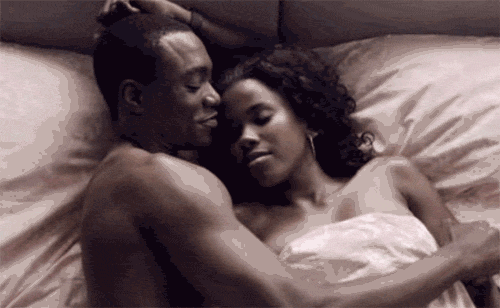 Giphy
GiphyI once read that 8 out of 10 people get stressed out over the holidays and 3 out of 10 lose sleep during to it — and when you’re stress-filled and sleep-deprived, that can absolutely lead to hypersensitivity, making mountains out of molehills and even not being in the mood for sex.
Your relationship can’t afford to go through any of this, so definitely make sure to prioritize rest. I don’t care how unrealistic it might seem during this time, sleep should never be seen as a luxury; it will always and forever be a great necessity.
That said, try to get no less than six hours of shut-eye in (check out “6 Fascinating Ways Sex And Sleep Definitely Go Hand In Hand”) and even ask your bae to take a nap with you sometimes (check out “Wanna Have Some Next-Level Sex? Take A Nap, Sis.”). Not only will sleep help to restore your mind, body and spirit but, when it’s with your partner, it’s an act of intimacy that can make you both feel super connected, even in the midst of what might feel like chaos.
___
Holiday season stress is real. Still, never give it the permission or power to throw your relationship off. Put you and your man first and let the holidays be what they are gonna be, chile.
Let’s make things inbox official! Sign up for the xoNecole newsletter for love, wellness, career, and exclusive content delivered straight to your inbox.
Featured image by Shutterstock
While doing a podcast interview a couple of weeks ago, when I said my age, the interviewer complimented me by saying that what I said is not what they would’ve guessed. When they asked what the secret was, the first thing that came out of my mouth was, “Oh, I’m gonna take me a nap.”
I adore sleep. I’ve said before that it’s like what Six Flags is to some people. And really, it’s just a plus that there are so many health benefits from getting plenty of rest. Beauty-wise, science does reveal that getting no less than seven hours a night can slow down signs of aging. Know what else? There are some direct things that sleep — and the lack thereof — can do to your immunity as well.
And so, since this is the time of year when catching a cold (and/or the flu) is common, let’s talk about the impact that sleep (and again, a lack thereof) has on your immune system. That way, you can remain as healthy as possible during the fall and winter seasons.
1. Less Sleep Means More Colds
 Giphy
GiphyLike I stated in the intro, I’m pretty sure you’ve heard somewhere that the fall and winter are the seasons when people are most susceptible to catching a cold or coming down with the flu. And that’s exactly why I thought I would start this all off by sharing the fact that some studies reveal that if you get less than six hours of sleep, on a consistent basis, you end up making yourself more vulnerable to coming down with both. In fact, some research says that only 18 percent of people who get six-plus hours of rest caught a cold while almost 40 percent who got less than that did.
The logic behind it all is sleep gives your body time to build up the proteins and cells (like cytokines and T-cells) that you need to fight off certain viruses. So, if nothing bothers you more than having a stuffy nose or stubborn cough when it’s cold outside, getting more sleep is one way to prevent that from happening to you.
2. Less Sleep Means More Allergy Symptoms
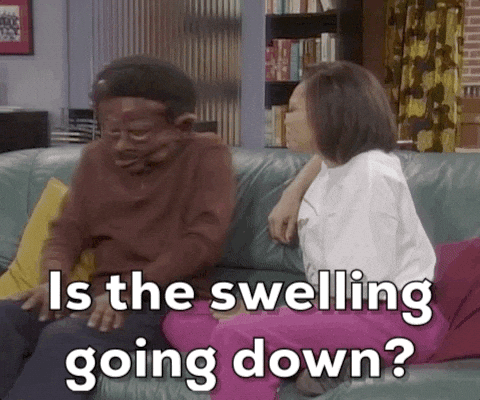 Giphy
GiphyAt the end of the day, an allergy is basically what transpires whenever your immune system “overreacts” to something that other people’s systems do not. And since sleep is what helps to keep your immune system nice and strong — well, I’m sure you get how less allergy-related symptoms and more sleep go hand in hand. Also, since sleep helps to decrease bodily inflammation (more on that in a bit) and inflammation can also intensify allergy symptoms, that’s just one more reason to get as much shut-eye as possible.
3. Less Sleep Means Potential Diabetes and Heart Disease
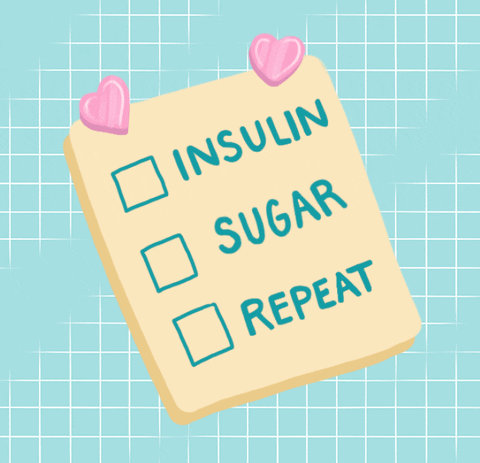 Giphy
GiphyDid you know that in 2024, Black women were diagnosed with diabetes 24 percent more than any other adult demographic. Also, it continues to be a reality that heart disease is the leading cause of death for Black women. These two sobering statistics alone should be enough of an incentive to do whatever you can to keep the risk of diabetes and heart disease way down.
One way to do that is by getting more sleep. Aside from the fact that sleep strengthens your immune system to where it is easier for you to fight off illness and diseases, sleep can keep your blood sugar levels in a healthy space; plus, when it comes to your heart, it gives it, along with your arteries and blood vessels a break.
4. Less Sleep Means Less Time for Your Body to Push “Reset”
 Giphy
GiphyIf you really stopped to consider all that your body goes through during the day (you can read some about that here), you definitely would respect it enough to do your best to thank it by giving it no less than six hours of sleep, each and every night. Sleep is what helps to slow your brain and body down so they are able to “refuel” for the next day. After all, how can your body prevent you from getting sick if your immune system is too worn out to fight ailments off? Exactly.
5. More Sleep Helps You to Fight Off Infections
 Giphy
GiphySpeaking of, in order for your body to fight off infections, there are certain cells and antibodies within you that need to be healthy and strong — one way that they get and stay that way is by you getting a good amount of sleep. For instance, remember when I touched on cytokines earlier? Well, the same way that they help to prevent colds, they also help to prevent infections too. And since sleep lowers your cortisol (stress) levels, rest gives your body the time and space to build up an army that can fight off free radicals and other health-related challenges while you are awake.
6. More Sleep Lowers Bodily Inflammation
 Giphy
GiphyWhenever a health-related issue is mentioned on this platform, inflammation is something that is mentioned quite a bit. Probably the easiest way to explain inflammation is it’s how your body responds/reacts whenever something is happening to your body that shouldn’t be, whether it’s an illness, an injury, a germ or something that you may be allergic to.
If you happen to have chronic inflammation, some symptoms that are associated with that include fatigue, stiff joints, skin rashes, weight gain and moodiness.
The interesting thing about all of this is if you aren’t getting enough rest, you could be triggering inflammation in your body. That’s because studies reveal that a lack of sleep can elevate molecules that are associated with inflammation. So, if you don’t want inflammation to increase within your system, you should definitely catch more zzz’s.
7. More Sleep Regulates Hormones
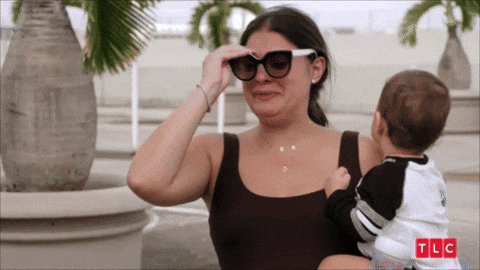 Giphy
GiphyWhen it comes to hormones like serotonin, estrogen and cortisol, believe it or not, they play a role in how your immune system acts and overreacts. That’s because, if your hormones are out of balance, that can cause your immune system to work harder than it actually should and that can make you more vulnerable to sickness. One way to keep your hormones leveled out? SLEEP.
That’s because sleep gives your body the opportunity to rest, repair and restore your hormone levels. On the other hand, when you are sleep deprived, that can put/keep your hormones on the ultimate roller coaster ride. #notgood
8. More Sleep Strengthens Vaccines
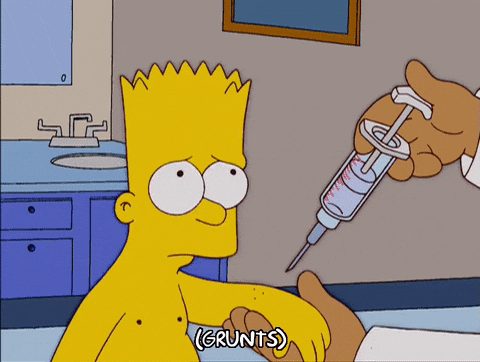 flu shot GIF - Find & Share on GIPHYGiphy
flu shot GIF - Find & Share on GIPHYGiphyIf you’re someone who is good for getting some sort of vaccine around this time of the year, make sure that you rest up before and after getting your shots. Not only does adequate rest before a vaccination help your immune system to be better receptive to your shots but sleep also helps your body to build up enough antibodies to make your vaccinations effective after getting them. Because if you’re gonna get pricked, shouldn’t it be worth it? My thoughts exactly.
Get some freakin’ sleep! Your immune system depends on it.
Let’s make things inbox official! Sign up for the xoNecole newsletter for love, wellness, career, and exclusive content delivered straight to your inbox.
Featured image by Shutterstock

